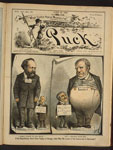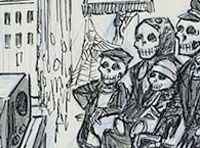Joe Jelen on Political Cartoons 2.0

Since Revolutionary times, political cartoonists in America have used their art to comment on the political and social landscape. While political cartoons in newsprint fade away, political cartoons have found a new home online and in social media. These cartoons often pack their punch with metaphors and subtle humor, which can leave students perplexed when unwrapping their meaning. However, grappling with this confusion through careful analysis can help students become politically savvy citizens.
Whether you are looking for the latest political cartoons or cartoons from the past, a number of useful repositories exist for your use.
One of the best places to find today’s political cartoons comes from the American Association of Editorial Cartoonists (AAEC). The site features several cartoons daily. In addition, the AAEC along with NIEonline.com maintains Cartoons for the Classroom, which features a weekly downloadable lesson and links to historical political cartoons.
For a weekly collection of cartoons, MSNBC posts the Week in Political Cartoons, which might be a useful way to review the week’s headlines with students.
Of course, you should also check out your local newspaper for political cartoons related to politics in your state or city.
If you are looking for political cartoons from the past be sure to visit the Library of Congress. A simple search of the Library’s online content reveals hundreds of cartoons available for download, many from the 18th and 19th centuries. In addition, the Library of Congress maintains this collection from the famous Herblock. Herb "Herblock" Block was active from 1929 to 2000, and his cartoons provide a liberal perspective on 20th-century political topics.
For Civil War and Reconstruction era cartoons, HarpWeek maintains a historical database of cartoons that appeared in Harper’s Weekly (published from 1857 to 1916). In the “Cartoon of the Day” collection, one can browse cartoons by topics, people, or places. Each cartoon is accompanied by a detailed explanation of its historical context and bibliographic information.
There are countless ways to help students make sense of political cartoons. To start making cartoon analysis routine in your classroom, you may want to download the Library of Congress’s Political Cartoon Analysis Sheet or the National Archive’s Cartoon Analysis Worksheet.
For a more in-depth approach to interpreting political cartoons, "It's No Laughing Matter" a webpage created by the Library of Congress, can help students better understand political cartoons. In addition to resources for teachers, the site has a great interactive lesson that helps students identify techniques used frequently in political cartoons. This unit plan from ReadWriteThink also provides a series of useful high school-level lessons for interpreting political cartoons.
If you find students struggle with analyzing elements of a political cartoon, try narrowing their focus. Have students examine one quadrant of the cartoon at a time and ask them to decipher what is happening. Often political cartoons have a lot of detail that can distract students from the overall message. In this case, a zoom-in inquiry could also help focus student attention. Along the same line, a document camera could be used to focus on specific elements of a cartoon to prevent students from bogging down in the details. It may also be helpful to have a scholar model the interpretation of a political cartoon. Here, historian Mike O’Malley analyzes a Thomas Nast cartoon related to the gold standard.
Have students practice interpreting political cartoons at home by creating a VoiceThread. You can upload a cartoon and have students identify elements of the cartoon with a video marker and add their commentary or questions (see an example).
Why not take students to the top of the new Bloom’s taxonomy and have them create their own political cartoons? With many web tools available, students need not worry about their drawing ability. Teaching History With Technology reviews several sites for creating comics online.
Political cartoons offer a great deal of content, if students are given the right tools to access and analyze it. The many websites now available for finding cartoons and helping make sense of them give us the resources to practice high-order thinking skills with students through interpreting and creating political cartoons. We should, therefore, give students ample opportunity to explore these cartoons in and out of the classroom.
Watch historians analyze political cartoons on the gold standard, the presidential election of 1932, massive resistance, and the My Lai Massacre in Examples of Historical Thinking.
Try Jonathan Burack's guidelines for interpreting political cartoons in Teaching Guides. John Buescher offers more advice in Ask a Historian.
See award-winning teacher Stacy Hoeflich introduce her 4th-grade students to a political cartoon in Teaching in Action.
Test your students' analytical skills with our quizzes on a Thomas Nast cartoon and a cartoon on massive resistance.
